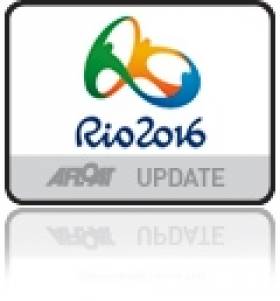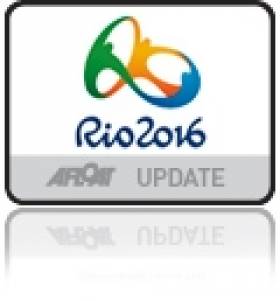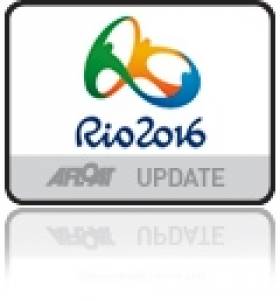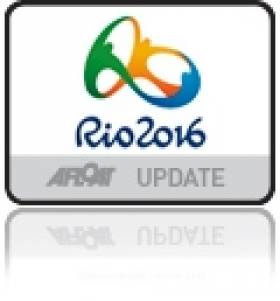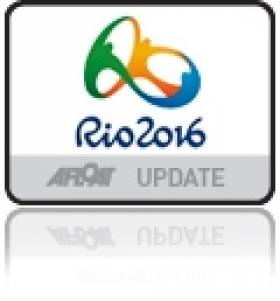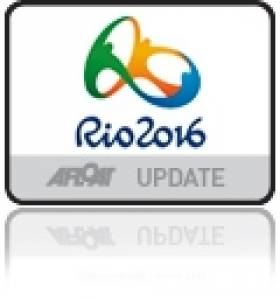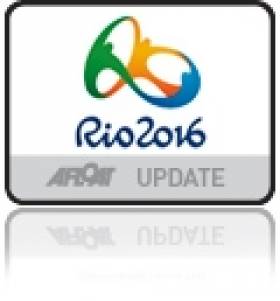Displaying items by tag: olympic sailing
#finn – These top Olympic sailors sure sure make it look easy but this is heavy weather Finn dinghy sailing at its finest. The six minute vid – complete with a head bashing sound track – shows the level of skill required to make it to the top of the Finn dinghy rankings.
Sailed in La Rochelle, France, this month, in winds of over 20 knots, this was filmed using stern cameras on each Finn. Giles Scott had already won the championship but went on the lead round the medal race for a seventh race win that week. Vasilij Zbogar did just enough to win the silver while Ed Wright (whose camera failed to work) took the bronze.
The film shows Finn sailing and Finn sailors at their best. The conditions were extreme, with exceptional competition among great athletes.
#swchyeres – After missing the gold fleet cut at both Miami and Palma ISAF World Cup regattas this year, Ireland's Olympic sailor Annalise Murphy showed the depth of her ambition in France this afternoon when she opened her Laser Radial account at the final round of ISAF's World Cup in Hyeres with a race win and a third place to lie just two nett points off the overall lead after the first three races.
After a fantastic day afloat in consistent 15–knot breezes, Annalise lies second overall tonight to Belgium's Evi Van Acker tonight and except for a slip in race two might well be heading up her 79–boat fleet. The Dubliner shares the same four points as the Belarussian Tatiana Drozdovskaya with only seven seven points separating the top ten.
Murphy was as far back as 28th after counting a 27th in race two but bounced straight back with a third in race three to be right in the frame in the early part of this qualification round.
It was a significant performance in the more than forecasted winds and in a fleet that contains the very best sailors in the world including two of the three London 2012 Olympic medallists. Results here.
Tweeting after coming ashore, Murphy told her followers: "I had a 1st, a shocker of a 27th and a 3rd today which should put me into third overall. Significant improvement from Palma!"
Van Acker looked to banish her Palma demons as she took two race wins and a fifth to lead in Hyères. The Belgian racer missed out on a podium spot at ISAF Sailing World Cup Mallorca as she engaged in a battle for silver with Tuula Tenkanen (FIN) in the Medal Race. She finished the Medal Race in 10th and fell to fourth, missing out on a medal. A strong performance in the Hyères has put her on the right route at the early stage of the event.
ISAF Sailing World Cup Melbourne gold medallist Tatiana Drozdovskaya (BLR) is third overall.
A confirmed number of 1,111 sailors racing in 765 boats from 59 nations are racing on the French Gold coast in what is a massive turnout to bring the ISAF Sailing World Cup series to a close.
In other Irish sailing team news from Hyeres, Murphy's London 2012 team–mates have also opened their French accounts each sailing three races today.
In the mens 49er skiff class Ryan Seaton and Matt McGovern are highly placed in tenth overall in the 79 boat fleet after scoring 3,6 and 7. Results here.
ISAF Sailing World Cup Mallorca gold medallists Martine Grael and Kahena Kunze (BRA) got their week off to a strong start after picking up two race wins and discarding a 14th.
The Brazilians are in familiar company atop of the leader board with many of the leading 49erFX sailors trailing them by a narrow margin.
Ida Marie Baad Nielsen and Marie Thusgaard Olsen (DEN) sit two points behind the Brazilians whilst Charlotte Dobson and Sophie Ainsworth (GBR), who took the days other race win, occupy third.
2013 World Champions and defending Hyères champions Alex Maloney and Molly Meech (NZL) found their form after a disappointing week in Mallorca. Recording a second, a discarded 19th and a third they sit in fourth.
James Espey lies 70th from 123 starters in the mens Laser division. Results here. Jean Baptiste Bernaz (FRA) took two race wins in the Laser and is the early leader in the 123-boat fleet. The French racer took two bullets from the day's opening encounters and came through with a ninth in the third and final race of the opening day.
With two fleets the remaining race victories went the way of Robert Scheidt (BRA), Jesper Stalheim (SWE), Andy Maloney (NZL) and Matt Wearn (AUS).
Ireland's Andrea Brewster and Saskia Tidey are 17th from 42 in the womens 49erfx skiff. Results here.
Disappointing Opening Rounds for Irish Olympic Sailing Team at Trofeo Princesa Sofía
#TrofeoSofia_en – In a light air day when risks ran high Annalise Murphy's arch rival Marit Bouwmeester (NED) picked up two race wins and leads the Laser Radial fleet. The Dubliner had to be content with a 32, 46 and 48 to place 88th out of 96 in what has been a disappointing opening day of racing for Ireland at the 2013-2014 ISAF Sailing World Cup regatta in Mallorca, Spain.
Racing in the yellow fleet the Dutch sailor took two close victories over Chloe Martin (GBR) in Race 1 and Tina Mihelic (CRO) in Race 2. Bouwmeester finished second in the third race of the day to solidify her leading position. Martin got the better of Bouwmeester in the final race and sits second.
In the blue fleet, in which Annalise is drawn, race victories went to ISAF Sailing World Cup Qingdao gold medallist Dongshuang Zhang (CHN), China's Min Gu and Sweden's Josefin Olsson. The Swedish sailor sits on three points tied with Martin and Zhang.
But there are still seven races left to sail so the massive regatta that has over 1130 sailors competing in 11 classes is far from over with double races scheduled until Friday. Tomorrow is another qualification day for prized gold fleet places.
It appears conservative racing was order of the day but so far the light winds have not suited any of the seven competing Irish crews.
Best of the Irish was James Espey in the Laser class, the Belfast single–hander lies 30th after scoring a 10, 13 and 8 in his 144 boat fleet.
Espey's London 2012 team mates Ryan Seaton and Matt McGovern are 57th from 79 after three races.
Newcomers Andrea Brewster and Saskia Tidey lie 39 from 50 and Royal Irish clubmate Ross Hamilton lies 82 from 92.
Full results are posted here. The forecast for Tuesday is for slightly more winds up to 11 knots.
No Sponsor But Record Number Set to Attend Trofeo Princesa Sofia – ISAF Sailing World Cup, Mallorca
#olympicsailing – Annalise Murphy will be the sole Irish Laser Radial campaigner in a 103–boat fleet in Mallorca in two weeks time at the latest round of the ISAF World Cup.
Murphy will be joined in Spain by London 2012 team–mates Ryan Seaton and Matt McGovern sailing the Irish 49er, 'The tighter the better'. Also in Mallorca, is single–hander James Espey in the Laser class.
In spite of the financial problems caused by the loss of the main sponsor only a few weeks ago the 45 Trofeo Princesa Sofia regatta is about to become a record edition.
Only two weeks to go to the start of the Majorcan regatta, to be held in the bay of Palma from 29th March to 5th April, a large number of entries have been received to confirm the Princesa Sofia as a must do event in the calendar of sailors from all around the world.
A large number of International teams are already training in the bay of Palma with view to the Trofeo Princesa Sofia.
With entries still open in some classes and increasing day after day, the 45th edition of the Trofeo Princesa Sofia, next to last stage of the ISAF Sailing World Cup, has 623 boats entered which add to a total of 882 sailors from 55 nations.
High participation in classes Laser, Finn and Nacra 17. With 70 boats entered, the Nacra 17 fleet, the new mixed multihull class, is a big surprise.
Furthermore, all Olympic classes will be present this year in the bay of Palma as it happened last year following some editions in which some class was missing due to a clash in the calendar with its Class event. The 2.4mR Paralympic class will also come again to Mallorca with a new venue at Real Club Náutico de Palma.
"We are very satisfied with the number and quality of entries received this year at the Trofeo Princesa Sofia –explains Ferran Muniesa, Race Manager -. We have gone through very tough weeks following the loss of our main sponsor, to whom we are grateful for their six-year sponsorship. The number of participants gives us the energy to continue working to deliver one of the best editions ever and confirms we are the favourite event for all sailors".
"I would like to thank all the team and the Organizing Clubs, Arenal, Can Pastilla and Palma, for the enormous effort they are undertaking despite the forced budget restrictions, to make sure the Princesa Sofia continues to be one of the best events in the world", adds Muniesa.
As in previous years, a large number of International teams are already training in the bay of Palma with view to the Trofeo Princesa Sofia. German, Polish, British and Danish teams, among others, have chosen Mallorca as winter training venue before the start of the European sailing season. Within this training programme, the Arenal Training Camps Trophy was held from 13th to 16th March.
In fact, the Sofia is the starting gun of the European calendar. It is also the next to last stage of the ISAF Sailing World Cup, following the event in Asia (Qingdao, China), Oceania (Melbourne, Australia) and America (Miami, United States). The next and last stop will be the ISAF Sailing World Cup Hyères, in France at the end of April. From that moment, all teams will focus on the ISAF Sailing World Championships to be held in Santander in September, an event to decide half of the nation slots for the Rio 2016 Olympics.
Olympic Sailing Team to Share €600k in Sports Council Funding
#rio – Buoyed up by the success of Annalise Murphy's Olympic performance (fourth overall) in Weymouth in 2012 and her Laser European title win in 2013, the Irish Sports Council (ISC) announced an investment plan for Olympic sailing for 2014, a critical year in the build up to the Rio Olympics.
Sailing received the third highest level of funding after boxing and athletics. This state investment included the allocation of €7m to 18 high performance sports including sailing.
Results from other Irish sailors also helped sailing cash in on government funding. Last year sailors won 13 medals, 8 of which were Gold at international events. Youth sailors did particularly well. For example, Finn Lynch took bronze in the Men's Radial Worlds, silver in the Europeans and Gold in the U21 category at the Laser European and World Championships in Dun Laoghaire.
2014 is a key year in the Olympic cycle as the first Olympic qualifier will be held in Santander, Spain in September. The target for the Irish sailors is to qualify the nation in all classes that they participate in.
Commenting on the announcement ISA Performance Director James O'Callaghan stated "The level of funding received from the Irish Sports Council is a reflection of the success of our high performance athletes".
There are 102 sailors training as part of the ISA Performance Pathway Programme starting from the junior classes through to the Olympic classes. All these sailors are closely monitored and follow strength and conditioning programmes managed by Sports Med Ireland physiotherapist Mark McCabe in addition to receiving regular coaching from top international coaches.
Dublin 49ers Expected for Ballyholme Nationals
#49er – For the first time in many years, Ballyholme Yacht Club (BYC) orgsnisers on Belfast lough are hoping for double figures for the Mackey Opticians sponsored Irish 49er nationals, especially if a few of the Dublin fleet travel for the October 5th event.
It will be a very busy weekend at Ballyholme bay with Race 4 of the Autumn Series on Sunday morning and Race 1 of the BYC Icebreaker series on Sunday morning.
London 2012 Olympians Ryan Seaton and Matt McGovern (currently competing at the 49er worlds in Marseille, France) have been working hard to organise boats for all the competitors.
There will be practice racing on Friday 4th for those who haven't stepped on a 49er in a number of years or ever before.
The briefing will be at 10:30 on Saturday morning with races starting as soon as possible afterwards. We hope for 6 quick races on Saturday with 3-4 on Sunday starting earlier. Sailing instructions will be available at the briefing and will be dependent on the weather conditions.
There is a perpetual trophy available for the winning 49er and Mackey Opticians are donating two pairs of polarized sunglasses (value up to £150 each) for the winning pair.
All Sailing Super Stars, By George
#rsgyc – The word on the grapevine is that the Royal St George Yacht Club, currently the Mitsubishi Motors "Sailing Club of the Year", is planning a special festive event to celebrate its 175th birthday. The whisper is that it will be a gathering to honour those members who have won major events and titles right up to and including Olympic medals.
We've been allowed a glimpse of the list, and it's very impressive. Which is what you'd expect from a club which has shown an extraordinary ability to adapt successfully to changing circumstances, while displaying a special talent for recruiting promising sailors from all round the country when they come to Dublin, either to go to college or to work.
Yet even as they keep a weather eye open for potential members who will give as much to the club as it will give to them, the club's administrators never lose sight of their past. And what a past it has been. Like many great clubs, it started modestly enough around 1838 as the Pembroke Rowing Club in south Dublin. But the oarsmen of the Dodder soon reckoned that the cleaner waters of the new harbour out on Dublin Bay, where Dunleary had recently been re-named Kingstown, would provide more pleasant conditions than the fetid Liffey.
As for their sport, several key members were thinking of moving into slightly larger craft, driven by sail. Suddenly, the new club took off. Boat sizes and numbers increased exponentially, the membership became rather grand and extremely wealthy, and by the 1850s the little rowing club had morphed into the Royal St George Yacht Club, with handsome and frequently extended premises on the waterfront, and a membership list which seemed to include just about every great landowner in Ireland who had the slightest interest in the rapidly growing sport of yachting.
In looking back from the present day, we tend to think that the modern emphasis on active participation is just that – a modern thing. Indeed, it's said that it was a member of the George, when it was at the height of its affluence, who occasioned the apocryphal story which captures the sprit of certain yacht owners at a time when most wealth was concentrated in very few hands. Cue to stately home somewhere in Ireland:
The Butler waits upon his lordship, and clears his throat in a meaningful manner.
His Lordship: "Yes, James".
Butler: "My Lord, I have just been in conversation with our land agent".
HL: "Indeed".
Butler: "And he tells me that we are living in financially stringent times".
HL: "Is that so?"
Butler: "Such seems to be the case, my Lord. In fact, the agent tells me that we may have to implement some cutbacks in the usual expenditure".
HL: "Nothing too severe, I trust".
Butler: "Well, my lord, I'm afraid the agent thinks that we may have to sell the yacht"
HL: "Sell the yacht?"
Butler: "Regrettably so, my Lord".
HL " Good heavens. D'you know what, James? I didn't know we had a yacht. Well, I do declare. Isn't life just full of surprises? I'll need to think about this".
But while there were George members who shaded towards this approach to yachting, there were others who really did sail the seas. One of the original Pembroke men, William Potts, had moved up from rowing to serious seagoing with the substantial new cutter Caprice, and in 1850 he cruised to Iceland.
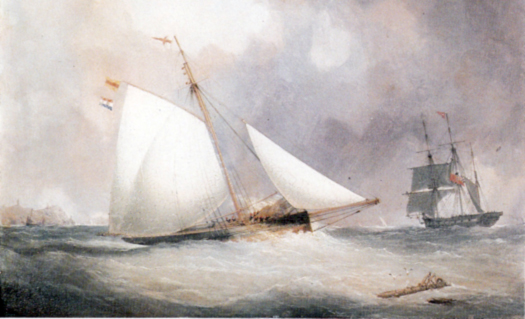
The cutter Caprice in which William Potts, a founder member of the Royal St George YC in 1838, cruised to Iceland in 1850.
As for the racing side of things, we have to remember that this was still in its infancy in terms of organisation even if Lough Erne YC had been formed in Fermanagh as long ago as 1820 specifically to run yacht races, and thus records of early sailing events are often incomplete and inconclusive. After all, the George had already been in existence for a dozen years when the schooner America won that famous race round the Isle of Wight in 1851, but the fact that it was a scratch event which took no account whatever of different yacht sizes in collating results shows indicates the relatively primitive site of the sport of yacht racing at the time.
But the rapid increase in wealth in the latter half of the 19th century meant that the development of yachting, and its regulation, accelerated markedly. In Ireland, it was in Belfast that economic growth became most rapid, and the new wealth accumulators from the north were keen to get involved. The Ulster Yacht Club did not get founded until 1866, and it became the Royal Ulster YC in 1869. But meanwhile one of the richest and most energetic of the new Belfast linen magnates, John Mulholland who later became Lord Dunleath in 1892, had been spreading his sailing wings as a member of the Royal St George.
By the 1860s, schooner racing was the apex of the sport, and in 1865 Mulholland commissioned the 153-ton schooner Egeria from the top designer-builder of the time, Wanhill of Poole. At just under 100ft LOA, the beautiful new vessel soon became known as "the wonderful Egeria", and for more than a decade she was the winner par excellence with more than sixty major trophies to her credit, while her owner was so fond of the boat that he kept her for many years after she had been out-classed as a racer.
In Egeria's competitive years, Mulholland was no absentee yacht owner. On the contrary, he seems to have been the Denis Doyle, the Piet Vroon, of his day, enthusiastically racing his lovely ship with a crew of 12 wherever there was good competition to be had. He embodied the best of the sporting instincts among the active yacht owners in the George, which had been a leading club in supporting the idea of "flying starts".
This marked a change from the early days of yacht racing, where the starting gun was fired with all competitors lying to their anchors. A flying start under full sail across an imaginary line was much more fun, and in Dun Laoghaire harbour it could be extremely sporty when the big yachts got crowded. As for the finishes, they were recorded by the naval officer/marine artist Richard Brydges Beechey, so we have a fair idea of what they could be like, but the image is augmented by an account of "the famous Egeria" making an in-harbour finish under full sail to win: "....what a fright the Egeria gave the multitude of yachts lying at their moorings when, on returning to Kingstown harbour she, on rounding the buoy, had so much way on that she absolutely ran through the crowd of yachts. The escape of many craft was little short of marvellous...."

A cutter finishing in the harbour at the Royal St George Regatta, 1871, as recorded by Richard Brydges Beechey. The larger schooner at anchor on left may be Egeria
By the time Beechey was recording the scene, cutters had taken over from schooners as the premier racing class, but here too the Royal St George was to set the pace with John Jameson and his legendary Irex. The Jameson family had been moderately prosperous whiskey distillers in Dublin since 1780, but in 1864 phylloxera wiped out the vines in the brandy districts of France. With brandy supplies dwindling, Irish whiskey and soda soon became such a fashionable drink internationally that the entire Jameson family entered the ranks of the mega-rich.

John Jameson's 1884-built cutter Irex was the most successful racing yacht of her era. She is seen here after winning the annual regatta of the Royal Harwich YC on England's east coast
John Jameson himself, while an extremely able businessman and talented sailor, was personally rather shy. However, his younger brother Willie was anything but, and the Jameson brothers with the 1884-built Irex were enthusiastic campaigners on all coasts with John the backroom boy, while Willie was front of house. And the fact that every time Irex won a regatta, the name John Jameson appeared in the newspapers was no harm at all for their whiskey sales. Then at Cowes Week after a spectacular race in heavy weather in which the Irex won by half a boatslength, as the brothers were anchoring afterwards, the rowing gig from the royal yacht arrived alongside and a written message was passed on board: "The Prince of Wales compliments and congratulations. His Royal Highness would be very pleased if Mr Jameson could join him for drinks before dinner".
John Jameson became hyper-shy, and said to Willie he couldn't be dealing with a situation like that at all. But Willie said not to worry, he was Mr Jameson too. So off he went to the party and got on so well he stayed to dinner. And when the Prince of Wales was planning the building of the superb Watson cutter Britannia a few years later, he asked Willie to be owner's representative during the building and commissioning, and subsequent racing.

The day Britannia came to call. The new royal cutter Britannia in Dun Laoghaire harbour in 1893 on her delivery voyage from the Clyde to the Solent, "and Mr Willie Jameson was seen on board". Note that a boomless gaff trisail is set instead of the full main.
Needless to say, nobody really believed it back in Dublin, so when the brand new Britannia was being sailed south to the Solent from the Clyde in 1893, Willie Jameson made damned sure she called to Dublin Bay, and the local papers duly reported that "Mr Willie Jameson was indeed seen on board". But while he was a great man for a party, Willie could be cussed enough. When the Britannia was being scuttled in 1936 in accordance with the recently-deceased George V's will, the Royal Family sent Willie Jameson her steering wheel as a memento of his time on board in a key role. But he promptly sent it back with a curt note saying that when he sailed the Britannia, she was tiller steered....
The Jameson standing in sailing was such that when Lord Dunraven decided it was time he took up sailing in the mid-1880s, it was as a member of the Royal St George and aboard Irex that he got his first taste of the sport, an experience which followed with his two increasingly acrimonious America's Cup challenges in the 1890s which, mercifully for the George, were made through the Royal Yacht Squadron to which the County Limerick peer had transferred his allegiances.
Back in Dublin Bay meanwhile, it was a very active and successful Royal St George sailing member, wine merchant George Black Thompson, who was one of the sailing men involved in codifying yacht racing through the Royal Alfred YC's pioneering work. But G B Thompson was primarily a George man, and just as it is with the club nowadays, he was keen to encourage promising newcomers. Thus in 1892 when his 5 Rater Shulah was becoming out-classed competitively but had the ability to become a fast cruiser, he was more than happy to sell her to two young brothers who had been teaching themselves to sail with a Water Wag dinghy up on Lough Dan in the Wicklow mountains, and now wanted to cruise.

G B Thompson, a leading member of the Royal St George YC for many years, introduced Erskine Childers to the possibilities of cruising in 1892. He succeeded Lord Dunleath as Vice Commodore in 1895.
Shulah's new owners were Erskine and Henry Childers. They soon took Shulah away from Dublin Bay with a cruise to the west of Scotland, where they laid the boat up and cruised the Hebrides again the following summer. After that, Erskine Childers began his career in London. He decided Shulah was too deep for his new cruising area in the Thames Estuary, and acquired the Vixen which, after a cruise to the Friesian islands and the Baltic, became the fictional Dulcibella, "heroine" of his best-seller novel Riddle of the Sands.
Published in 1903, the Riddle of the Sands hinted at the possibility of war between Germany and Britain, which duly came in 1914. But at the same time many of the Royal St George members were facing their own problems with the breaking up of Ireland's largest estates under the Land Acts. That and the Easter Rising of 1916 and the establishment of the Irish Fee State in 1922 meant that in the space of just three decades, the club had gone from affluence to a relatively sparse existence.
Yet somehow it adapted, and in time the club was back in the forefront of sailing in an Ireland which may have seemed changed. But was it really? As a member of the new Free State Government put it, "we are the most conservative revolutionaries ever seen". So, far from the relics of ould decency like the old royal yacht clubs being wiped out, in time they began to thrive again, and by the mid-1930s the George was extending its forecourt to accommodate sailing dinghies such as the Water Wags, while members also were involved in forming the new 17ft Mermaid class
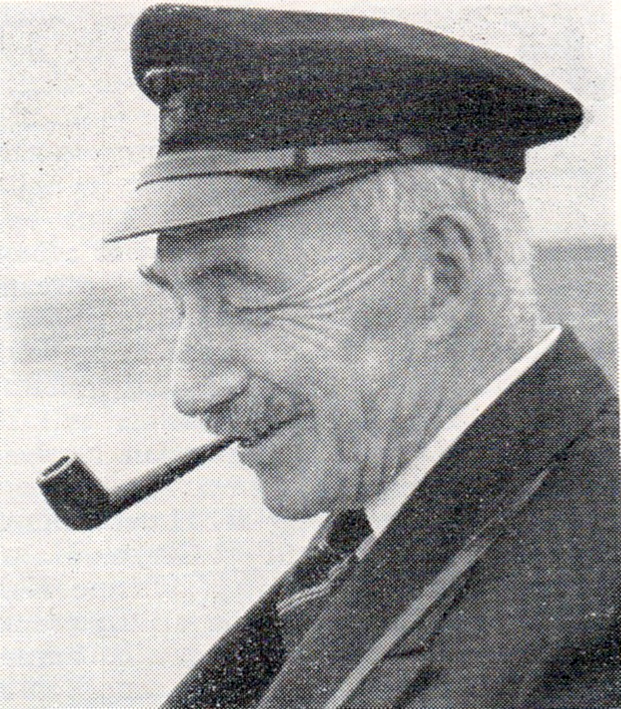
Billy Mooney, who had sailed from Howth between 1919 and 1943, then moved to live in Sandycove and became very active in the Royal St George, of which he had already been a member for many years. A founder member of the Irish Cruising Club, he is seen here at the age of 74 when he was still to be seen sailing as a member of the George squad in Firefly Team racing, another area of sailing in which the club played a pioneering role.
As World War II ended in 1945 and international sailing resumed, the club was right in there, with a leading member, Billy Mooney, winning his class in the 1947 Fastnet with his 43ft ketch Aideen. The Mooney family – Billy and his son Jimmy - were a formidable force in sailing, and were also in the forefront of the establishment of the Irish Dinghy Racing Association. It was a fellow dinghy enthusiast, Douglas Heard, who was to become the first "commoner" to be Commodore of the Royal St George, succeeding the Earl of Iveagh, one of the Guinness family, in 1960.
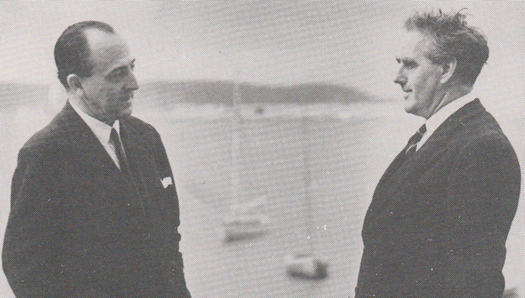
Douglas Heard (left) and designer Uffa Fox discussing the new Huff of Arklow on the club veranda in 1950

Well ahead of her time. Douglas Heard's Flying Thirty Huff of Arklow, designed by Uffa Fox and built by Jack Tyrrell, incorporated design features which were not generally adopted in offshore racing boats for another thirty-five years. Photo: W M Nixon
There was of course nothing common about Douglas Heard, who somehow found time to record the Irish sailing and boating scene on film while at the same time being an active participant, as his interests encompassed just about every branch of sea sailing, while his passions included the preservation and restoration of Ireland's inland waterways. Offshore racing and distance cruising were among his activities, and in 1950 he had his friend the innovative designer Uffa Fox create the plans for a Flying Thirty racer/cruiser. In effect a double size Flying Fifteen, this very advanced boat was built by Jack Tyrrell in Arklow, and though she was so far ahead of her time as to inevitably have weaknesses on some point of sailing, off the wind she was unbeatable while her seagoing credentials were amply demonstrated by cruises to Iceland and the Azores.

Three stages of development in the Royal St George YC premises. The clubhouse (right) in the 1880s. when there was much more in the way of green spaces on the Dun Laoghaire waterfront.......

.....and in 1934 shortly before the forecourt was extended to provide improved dinghy space and better access to deep water....

......and the Royal St George Yacht Club today, providing full facilities for all branches of sailing. Photo: David O'Brien
In compiling the first provisional list of the George's significant sailing award winners which currently goes back only to 1946, the organisers of the upcoming 175th Anniversary celebrations have produced 12 pages of data, many of them very tightly packed with names. The word is that this list will soon be available to members so that anyone who thinks that he or she (or an ancestor) has been overlooked can have their claims to inclusion considered. Outsiders seeing it may note names which are better known for their associations with other clubs, but the fact that they are George members, or were at the time of their achievement, is inescapable.
As it stands, it's a formidable data-base. You get the flavour of it by the listing of Olympic sailors. Since 1948, when Alf Delany and Hugh Allen raced in the Olympics two-handed class, members of the Royal St George YC have been involved more often than not, the only post World War II Olympics in which they haven't sailed for Ireland being 1956, 1968, 1984, and 2000, with the supreme achievement being the Silver Medal won by David Wilkins in 1980.
The Irish Helmsman's Championship has also been a happy hunting ground, with Douglas Heard winning an early staging in 1947 while the most recent was Tom Fitzpatrick in 1998 in a lineup of 16 winners. But such achievements are only the peaks of a broad swathe of success which has encompassed an extraordinary range of members and boats going right back to 1838. So it is timely that the club should be celebrating its own achievers in this the year of its 175th birthday, as the Club of the Year trophy was mainly in recognition of the Royal St George Yacht Club's achievement in staging the hnyper-successful Youth Worlds in 2012, and providing support and encouragement for the University College Dublin team as they underwent their rigorous buildup towards runaway success in the Student Yachting Worlds just eleven short months ago.
It will be quite a gathering, this cheering of the champions. All things considered, we can surely agree that the seagoing section of the Pembroke Rowing Club has done rather well.
#LaserEuros2013 – Annalise Murphy goes into the final races of the Laser European and World Championships tomorrow on her native Dublin Bay with a comprehensive 17 point lead ahead of Holland's Olympic silver medallist Marit Bowmeester.
With the prospect of a breezy finale on the waters off Dun Laoghaire Murphy is looking to resume the same kind of form which has led to seven wins from her nine starts here and convert her big lead to her first major Laser Radial title. A disappointing 27th in today's light breezes is her discardable result.
In contrast the contest for the titles and trophies in the Olympic men's fleet is very delicately poised after two tricky races in light and unpredictable northerly winds today which made consistency very elusive. Indeed of the top ten sailors in the Men's fleet all sailed one good result and one poor, discarded race.
As Britain's Nick Thompson promoted himself to the top of the standings with a second place in the second of their pair of races today to earn a two points margin ahead of Croatia's Tonci Stipanovic and three up on Holland's Rutger Schaardenburg, Brazil's Robert Scheidt returned to shore frustrated to have scored his second poor result in consecutive days. After winning the first race he fell into a wind hole in the second contest and struggled to a 24th.
Scheidt, who will bid for his ninth Laser world title in Oman in November, has returned to the class after seven years in the Star keelboat. He believes that racing in amongst most of the best in the class at the moment he is close to being back to his best, but needs to polish up on his consistency.
"I think that independent of tomorrow's results I have the chance to win regattas the way that I am sailing." Scheidt confirmed today, "I think that I have already proven this week that I sail well in strong winds, I can sail well in light winds. I am still not as consistent as I used to be but it shows the field is pretty open and I can still do well."
After taking time out from the Laser Thompson, who missed out on the British Sailing Team's selection to the last Olympics despite twice finishing runner up at consecutive World Championships behind Australia's Tom Slingsby, would love to mark his return with the first major title of his long and distinguished career. Since winning the 2004 ISAF Youth World title in 2004, Thompson has won world cup and international regattas but has yet to win a major class title.
"I am pleased with the way I have sailed at the event so far" Thompson said, "I have made few mistakes. The Worlds is the main focus but this event is hugely important, but for me it is nice to feel I am sailing back on top of my game again. The competition is great with Rutger, Scheidt and Tonci all up there and so I am looking to an interesting final day."
Thompson's pair of results – a 30th and a second – were characteristic of the day's highly unpredictable conditions. In the offshore northerly breeze, choosing the best side of the first beat was key but there were big holes in the breeze which summarily halted many of the top seeds in their tracks.
Croatia's Tonci Stipanovic, twice European champion in the past, has a slightly better discard in his locker, but Thompson has been better in the stronger breeze, scoring best of the fleet in Wednesday's wilder winds.
Although the men finished two races for the Olympic rigged fleets, the corresponding Women's Radial class only managed one because the fickle breeze died away too much. Murphy was disappointed not to have the chance to atone immediately for her disappointing 27th place, while Bouwmeester was also dismayed that only one race in her preferred lighter conditions was sailed.
The Dutch sailor said "It is a shame to only get one race. It looked like a bit of an early decision. That is a shame. It was a tricky race which reminded me a bit of Weymouth in the N'ly wind, so it was nice to race in that again. I was just in the top group at the windward mark and then got up to second on the second upwind. But we will be back hiking again tomorrow."
Annalise Murphy says she will change nothing for the decisive final day, concentrating on making better starts than today's which was the start of a frustrating downwards spiral which was concluded when she ran out of breeze close to the finish line. "It was difficult" Murphy said, " I had a bad start and struggled to get into the race in the first half, but made a good comeback on the second upwind, the last downwind and the reach to get into the top 15. But I was close to the finish line and then the wind died. I was not moving and could do nothing at all about it. I lost 15 places at the finish line and so that was disappointing. It was a shame not to get a second race in. The breeze came in but it is always hard to tell."
"I am disappointed with today. I would much preferred to have a 15th rather than a 27th or whatever it is. I will just have to get out there and have good races on the last day. I just need to get better starts than today's and try and not make any mistakes."
While Bouwmeester rose to second overall she is now just three points up on Britain's Ali Young.
In the Men's Laser Radial World Championship Australia's defending champion Tristan Brown won again to build his lead to 18 points. Ireland's Finn Lynch, the home club's ISAF Youth World Championships silver medallist leads the European Championship by two points ahead of Poland's three times world champion Marcin Rudawski. Lynch, who has climbed the rankings all week, is set for a place on the podium if her can maintain his current form in the final rounds.
Lynch, who sails from the National YC said "The conditions were very shifty and challenging conditions today. I had a good start and was in 10th at the first mark and then climbed to first but then dropped to third at the line. Tomorrow I am hoping for two solid races and to hold on to a podium position tomorrow."
Top three by class
Laser Radial Women's European Championship
1. Annalise Murphy, IRL, 9 points
2. Marit Bouwmeester, NED, 26
3. Alison Young, GBR, 29
Laser Radial Men's World Championship
1. Tristan Brown, AUS, 12
2. Finn Lynch, IRL, 30
3. Marcin Rudawski, POL, 32
Laser Standard Men's European Championship
1. Nick Thompson, GBR, 29
2. Tonci Stipanovic, CRO, 31
3. Rutger Schaardenburg, NED, 32
http://www.lasereuropeans2013.com/ for full results.
Irish Olympic Sailing Campaign Change as Brewster & Tidey Emerge in New 49erFX Bid
#rio – In the first twist in Irish Olympic sailing's build up to Rio 2016, there's been a major reshuffle in Irish women's skiff sailing. The change comes just months after two separate high profile campaigns were announced. Rival women's 49erfx campaigns have apparently merged this month, leaving two former opponents establishing a new double-handed bid.
Helmswoman Andrea Brewster from one team and crew Saskia Tidey from another pairing have teamed up as a new crew combination seeking the qualification standard for Rio 2016.
Although Claudine Murphy and Brewster announced their four year campaign in May – talking up how delighted they were to be sailing together – the pair have split after just three months.
According to an August 31st posting on the team facebook page, Murphy, elder sister of Laser Euro champion Annalise, is returning to medical studies at UCD.
The last event the pair competed in was the 49er/FX British Nationals. While they say they had made progress in the new class, they also conceded some aspects of their sailing were 'not so brilliant!'.
'We are sad to announce that our campaign has come to an end', they said.
According to the statement, Brewster is continuing to campaign for Ireland in the debutante class, teaming up with Saskia Tidey, the crewing partner of Belfast lough helmswoman Tiffany Brien, Ireland's other 49erFx campaign.
While there is no word of any replacement crew for Brien's campaign, the former Miss Northern Ireland was back sailing an RS Elite at the British Nationals on Belfast Lough in August.
Annalise Leads Laser Europeans on Dublin Bay Home Waters
#lasereuro2013 – Local favourite Annalise Murphy keeps her impressive form on her home waters as she leads the Women's Laser Radial European Championship by five clear points tonight. With four qualifying races sailed at the Laser European & World Championships on Dublin Bay, the 23-year-old Dubliner counts three race wins, discarding a second place from the first race today.
Its not the only division in this massive 324–boat regatta where Ireland is leading. Baltimore Sailing Club's Fionn Leyden leads the Men's Laser Radial World & European Championship category. The under–21 star in the Laser class had a second and a fourth yesterday in a consistent showing to put him firmly on top of his class. In a further boost for Ireland in this 90-boat fleet, 2012 ISAF Youth Silver medallist Finn Lynch is lying fifth overall.
Murphy has both of the 2012 Olympic medallists behind her. Neither Holland's silver medallist Marit Bouwmeester nor Belgium's bronze winner Evi Van Acker have been able to maintain anything close to Murphy's consistency, both scoring one relatively weighty score apiece today. Bouwmeester, the 2011 World Champion, claims to be just getting used to the testing offshore westerly winds which produce big shifts in wind direction and pressure. "At the moment it seems best to follow Annalise" Bouwmeester joked as she returned ashore to Dun Laoghaire's National Yacht Club.
In the other Olympic class, the Men's Laser Standard Rig, Australian Ashley Brunning tops the overall table counting two firsts and a second to lead Holland's Rutger Van Scahaardenburg, Sweden's Jesper Stalheim and the ominous presence of Brazil's five times Olympic medallist Robert Scheidt who matched Brunning's first and second place qualifying race finishes today.
Brunning leads a strong Australian presence with four of their squad in the top 25 in these early qualifying races when points are tight and evenly spread. His preparation in Europe is paying an early dividend, while Schaardenburg – who leads the European Championship – could not quite maintain his Day 1 speed edge in the choppier conditions of the offshore course where the Men were racing today. "One and two is solid, I sailed really consistently and did not make too many mistakes and that is a sailboat race" affirmed Brunning, " I have been living in Europe for the last six or seven months, training with some other teams and of course my own Australian team. I have been in Sweden a lot, and so these are quite similar to the conditions around Gothenburg and so that helps".
"I think our team works so well because we all live close together in Sydney. We all train together. We work hard together and share everything together. We are very open and in terms of fitness and sailing we work hard together. Obviously having a mentor like Tom Slingsby and Michael Blackburn are good people to learn from. The squad here are doing really well. We were all charging together today and I think we are all in the top 15 so we are going well" Brunning continued.
Scheidt appears to be raising his game progressively "I was happy that the breeze was not as strong as expected. It was not extremely windy and the race course which we sailed on was much better than the one we sailed on yesterday. The breeze was a bit more steady and a bit more predictable than the other course. A second and a first was good enough for me for the day. The first race I was second at the top mark. The second race I rounded second and passed the Estonian guy and there are three of us who had a big lead on the group. I have some solid results so I am pretty happy. I am really looking to get a good range of wind conditions so it tests everybody's skills. That would be the best for everyone".
Annalise Murphy remains cool and confident in the Women's Laser Radials but cautions that it is still very early in the regatta, and lighter winds are expected Tuesday. "It is nice to have all low scores at this point when some of the others had some higher scores today. But then again that can all change in a few races."
"First and second was pretty good overall for the day. It was very difficult on the different course, the wind pressure was up and down much more, sometimes there was five knots in some places and then 20 knots in others, and very changeable in direction too."
"The wind was moving through 60 degrees or something like that. But I really enjoyed it. The first race I sailed pretty perfectly on the upwind, but I was sitting in no wind on the downwind with the fleet coming down at me but there was nothing I could do. That was a bit frustrating because I already had a big lead. The second race I got a good start, was first at the first mark and just held on."
For the 2012 Olympic medal winners in the fleet some of whom took time out after the Games coming back into the white heat of competition is about playing catch up again quickly. Cypriot Pavlos Kontides, who won his island nation's first ever Olympic medal when he took silver, may be a national hero now but he has been back to Southampton to complete his BSc degree in Ship Studies. He got back to the Laser in June while Belgium's bronze medal winning Evi Van Acker is just six weeks back in the boat after a 13 month layoff. She won the first race in her fleet today and paired it with a fourth after capsizing on the final beat.
Van Acker commented "I had two mega-comebacks. Twice I was very bad at the first mark, but the first race I won and the second race I was bad off the start but got up to second and then capsized on the final upwind and dropped to fourth. So for someone who has not really sailed in 13 months then a 1 and a 4 is not so bad. I started again six weeks ago. I have finished my studies now and so only have my thesis to go (on sports drinks). I am back into it, full time from here. There have been so many changes since the Games, I bought an apartment, renovated it, moved in with my boyfriend, so a lot of changes. I tried to stay fit. It is good it was shifty because you are not having to hike for too long".
While the charismatic Kontides is now fully focused on his programme for the future, scoring a 13th and fourth today "It could be better, it could be worse. It was a medium, conservative day for me really. It is strange conditions because if you get it wrong off the start then you immediately lose a lot of metres, and then it's hard to get back into the race".
"I did not do so much sailing in the early part of the year because I had to finish my studies, so now I have a BSc in Ship Science. I came back in June so obviously a lot of the other guys have done way more racing than me, but I think it is coming back nicely in the next few days."
"It has been really nice since winning the medal, nothing has changed in my life, people recognise me, it is a nice incentive to know you are a national hero and that is a great incentive going on, but what really has changed now is that I have finished my studies and I can focus on my sailing because that is what gives me the most pleasure in my life."
cliick here for full results.



























